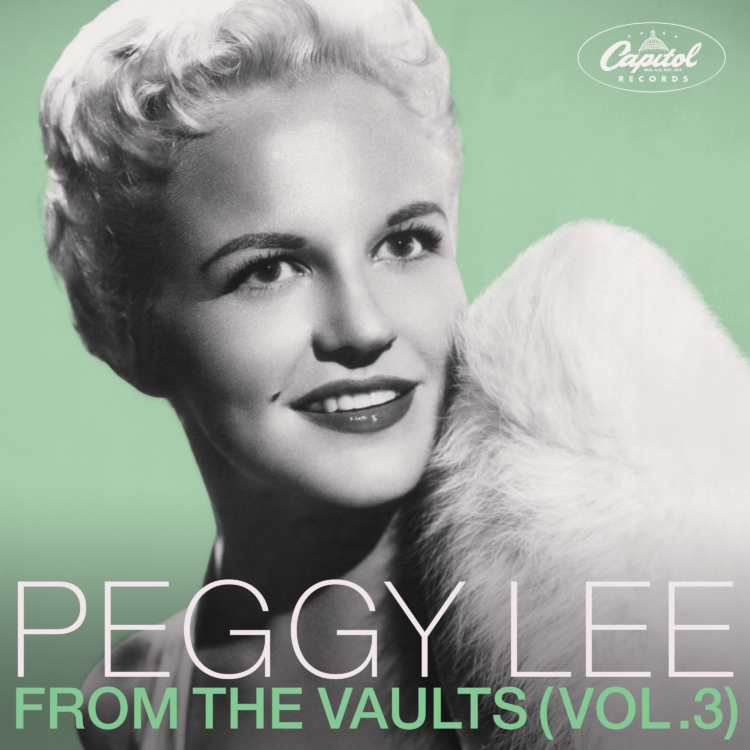Capitol Records / Universal Music Enterprises
Release date: September 13, 2024
LOS ANGELES, CA – September 13, 2024 – Capitol Records and Universal Music Enterprises (UMe), in conjunction with Peggy Lee Associates, today release Peggy Lee: From the Vaults (Vol. 3), the third installment in the new digital series that features rare tracks currently unavailable on streaming platforms.
Recorded for Capitol between 1951 and 1972, the 13 selections on From the Vaults (Vol. 3) include songs from emerging songwriting giants Burt Bacharach and Jimmy Webb, a popular song by television pioneer Steve Allen, one co-written by Peggy Lee herself, Tin Pan Alley and jazz standards, alternate versions of four songs, and another three songs that remained unreleased in Lee’s lifetime (1920-2002).
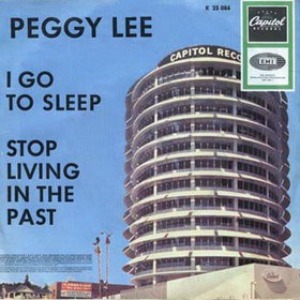
“Stop Living in the Past” is the title of one song included on From the Vaults (Vol. 3), and as a recording artist, Lee was as forward-looking as she was nostalgic. Mentored by the great lyricist and composer Johnny Mercer when she began songwriting in the 1940s, Lee paid it forward by recording songs by young, emerging talents throughout her career. In 1957, Lee introduced “Uninvited Dream” by Burt Bacharach, then in his late 20s and soon to enjoy his first chart successes with “The Story of My Life” and “Magic Moments.”
Jimmy Webb also enjoyed major success as a songwriter in his 20s, and Lee was one of many artists to record his song “Didn’t We.” She recorded it during a 1969 session for her album Is That All There Is? but the song was not included. Television audiences saw her sing it that same year on her documentary special The World of Peggy Lee, which chronicled her rehearsal and performance process.
Of Lee’s recording Jimmy Webb offers: “The Peggy Lee cover of my song ‘Didn’t We’ is an exquisite reading and a typically well-crafted vocal performance that Ms. Lee was known for. Each word is given special significance, which is a vocal skill rarely heard today. To hear her voice on this lost recording of one of my songs is a warmly welcomed surprise.”
From Lee’s songwriting catalog comes “I Love You but I Don’t Like You,” co-written with Heinie Beau, saxophonist, clarinetist, arranger, and conductor, who regularly worked in the 1940s with Lee and her first husband, guitarist and hit songwriting partner Dave Barbour (“It’s a Good Day,” “Mañana”). “I Love You but I Don’t Like You” was recorded in 1951, when Lee and Barbour divorced. Later that decade, Lee would partner with several musical greats on successful songs, including Victor Young (“Where Can I Go Without You”), Duke Ellington (“I’m Gonna Go Fishin’”), and Sonny Burke (the songs from Walt Disney’s Lady and the Tramp).
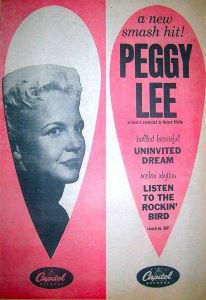
Four songs featured in From the Vaults (Vol. 3) are alternate takes with notable differences from their released versions: “Uninvited Dream,” significantly rearranged for release on a 1957 single; “A Taste of Honey” from Lee’s Grammy-nominated 1963 album I’m a Woman; “Me and My Shadow,” the B-side of Lee’s Grammy-winning 1969 single “Is That All There Is?” and also included on the album of the same name; and “I’ll Be Seeing You,” the final track on Lee’s final album for Capitol, 1972’s Norma Deloris Egstrom from Jamestown, North Dakota.
Other songs included in From the Vaults (Vol. 3) are “No More,” a jazz standard by Toots Camarata and Bob Russell that was introduced by Billie Holiday, and “This Could Be the Start of Something Big,” the most successful song penned by television pioneer Steve Allen, on whose shows Lee guested numerous times. Both songs were unreleased in Lee’s lifetime, along with the aforementioned “Didn’t We.” The collection is rounded out by the non-album singles “Ev’rytime,” “Maybe This Summer,” “Stop Living in the Past,” “Tonight You Belong to Me,” and “Would You Dance with a Stranger.”
With the release of the four-volume From the Vaults digital series, Lee’s entire catalog of issued master recordings from the Universal family of labels — Capitol, Decca, A&M, and Polydor — will be accessible via digital streaming. The fourth volume will compile duets and other musical collaborations recorded between 1947 and 1972, Lee’s last year under contract with Capitol Records.
To read about previous volumes of From the Vaults: Vol. 1 | Vol. 2.
From the Vaults (Vol. 3) Track Listing
Dates in parentheses denote recording date
- I Love You, But I Don’t Like You (Heinie Beau, Peggy Lee) (5/16/51)
- Tonight You Belong to Me (Lee David, Billy Rose) (5/16/51)
- Would You Dance with a Stranger (Giovanni D’Anzi, Ray Miller) (12/17/51)
- Ev’rytime (Tony Iavello, Mel Leven) (2/18/52)
- Uninvited Dream (Burt Bacharach, Sammy Gallop) (4/22/57)*
- A Taste of Honey (Ric Marlow, Bobby Scott) (1/3/63)*
- This Could Be the Start of Something Big (Steve Allen) (5/31/63)
- Maybe This Summer (Arthur Altman, Bruno Brighetti, Bruno Martino, Al Stillman) (6/18/65)
- Stop Living in the Past (Howlett Smith) (6/18/65)
- Me and My Shadow (Dave Dreyer, Al Jolson, Billy Rose) (1/29/69)*^
- No More (Toots Camarata, Bob Russell) (2/12/69)
- Didn’t We (Jimmy Webb) (10/14/69)
- I’ll Be Seeing You (Sammy Fain, Irving Kahal) (4/28/72)*
*alternate version
Song Notes
I Love You, but I Don’t Like You (Henry J. “Heinie” Beau, Peggy Lee) (5/16/51)
Heinie Beau (1911-1987) was a clarinetist, saxophonist, composer and arranger who worked with several singers, Frank Sinatra and Ella Fitzgerald among them. Beau worked regularly in the 1940s with Lee and her first husband, guitarist and hit songwriting partner Dave Barbour (“It’s a Good Day,” “Mañana”). The Beau-Lee “I Love You, but I Don’t Like You” was recorded during a May 16, 1951 session led by the great conductor-arranger Billy May, who later backed Lee on her Capitol albums Pretty Eyes and Christmas Carousel. “I Love You…” was originally released as a Capitol single, with the song “Wandering Swallow” from the same session as its flipside. Beau and Lee also co-wrote “Little Old Car,” featured on her Decca album Sea Shells.
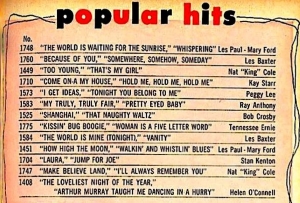
Tonight You Belong to Me (Lee David, Billy Rose) (5/16/51)
Recorded with Billy May on the same May 1951 recording date as “I Love You but I Don’t Like You,” “Tonight You Belong to Me” appeared on a Capitol single with the May-backed “I Get Ideas,” which proved to be Lee’s 27th chart hit (including her hits with Benny Goodman for Columbia/OKeh) and the last charting single from her first tenure at Capitol (1944-52). “Tonight You Belong to Me” dates to 1926 when it was first recorded by Irving Kaufman, and not long after by Gene Austin, who scored a hit with it in 1927. Only a few other singers recorded it before Lee’s 1951 version; it was later recorded by Vic Damone, Frankie Laine, the Mills Brothers, and Kay Starr, among others. Five years after Lee’s recording, a version by the young sister duo Patience and Prudence reached #4 on the Billboard charts and was Liberty Records’ best-selling single of 1956.
Would You Dance with a Stranger? (Giovanni D’Anzi, Ray Miller) (12/17/51)
“Would You Dance with a Stranger” is adapted from the Italian song “Sotto un cielo di stelle” by Giovanni D’Anzi and Alfredo Bracchi, with an English lyric contributed by Ray Miller. The song remains largely obscure, although it was sung by Mari Wilson in the 1985 British drama Dance with a Stranger starring Miranda Richardson and Rupert Everett. Lee’s recording, conducted by Sid Feller, shared a 1952 Capitol single with the Western swing song “Shame on You” by Spade Cooley.
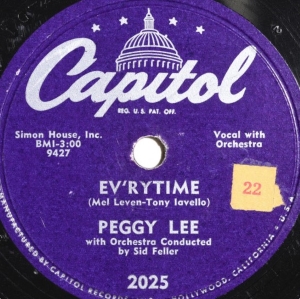
Ev’rytime (Tony Iavello, Mel Leven) (2/18/52)
Lee was one of only a few singers, along with Sue Raney and Frances Wayne, to record “Ev’rytime” by Tony Iavello and Mel Leven, which is not to be confused with the similarly titled and more frequently recorded “Ev’ry Time” by Hugh Martin and Ralph Blane. Lee’s version shared a Capitol single with “Goin’ on a Hayride” by, coincidentally, Blane, from his Broadway musical Three Wishes for Jamie. This February 18, 1952 recording session with Sid Feller in New York, where Lee had temporarily moved to pursue television and radio opportunities, proved to be her final one before she moved to Decca Records. Her five-year affiliation with that label yielded her beloved album Black Coffee, her commercial recordings of songs she co-wrote for Walt Disney’s Lady and the Tramp, and several hit singles, including “Lover” and “Mr. Wonderful.”
Uninvited Dream (Burt Bacharach, Sammy Gallop) (Alternate Version) (4/22/57)
After five years with Decca, Lee returned to Capitol in April of 1957 under auspicious circumstances to make the all-ballad album The Man I Love, arranged by Nelson Riddle and conducted by Frank Sinatra. That same month she recorded three non-album songs: “Baby, Baby, Wait for Me” and “Every Night,” which shared a singles release, and “Uninvited Dream,” written by Sammy Gallop and Burt Bacharach, the latter still in his ‘20s. The version of “Uninvited Dream” heard here, featuring a male choral backing, was not the one that Capitol released in 1957. Four months later, Lee rerecorded the song with a subdued ballad setting, and that version appeared on a Capitol single paired with “Listen to the Rockin’ Bird.” Riddle is credited on the released version but his involvement with this version has not been verified. Lee introduced “Uninvited Dream” and later another Bacharach song, “My Rock and Foundation,” which he wrote with Hal David. She also covered the Bacharach-David hits “Always Something There to Remind Me” and “Raindrops Keep Fallin’ on My Head.”
A Taste of Honey (Ric Marlow, Bobby Scott) (Second Alternate Version) (1/3/63)
“A Taste of Honey,” with music by jazz pianist Bobby Scott and lyrics by Ric Marlow, was first heard instrumentally by Scott and his quartet in the 1960 Broadway production of the same name. An original cast member, Billy Dee Williams, made the first vocal recording in 1961. Lee was among several major recording artists to record it in 1962-63, along with the Beatles, Tony Bennett, Julie London and Barbra Streisand. Scott’s own version received a Grammy award for Best Instrumental Theme in 1963, and a hugely popular 1965 version by Herb Alpert and the Tijuana Brass won three Grammys. Morgana King’s 1964 version became a signature song for her. Lee’s version, recorded January 3, 1963, first appeared on her Grammy-nominated album I’m a Woman. This alternate take first appeared on a 2004 CD reissue of the album, and is most noticeably different, according to discographer Ivan Santiago-Mercado, for the pause Lee takes between the words “sweeter” and “than wine” around 1:12.
This Could Be the Start of Something (Big) (Steve Allen) (5/31/63)
Television and radio host, comedian, actor, writer and pianist Steve Allen was also a prolific songwriter who estimated that he wrote 8,500 songs. Only “This Could Be the Start of Something (Big)” was widely performed and recorded, including versions by Tony Bennett, Bobby Darin, Ella Fitzgerald, the Four Freshmen, Aretha Franklin, Judy Garland, Jack Jones, Barbara McNair, Mark Murphy (the first to record it), and the team of Steve Lawrence and Eydie Gorme. Lee’s 1963 recording, from another session led by Billy May, remained unreleased until 2005, when it debuted on the Capitol CD compilation High Rollers from Las Vegas. Lee’s association with Allen began in the early 1950s, when she performed on his morning television show. She then guested three times on his evening show in 1957-60. On a 1959 episode, Allen dueted with Lee on the opening verse to her debut performance of a song she recently co-wrote with Sid Kuller, “How Do You Erase a Memory?” Allen and Lee co-wrote two songs, “All for You” and “April Rhapsody,” neither of which Lee recorded.
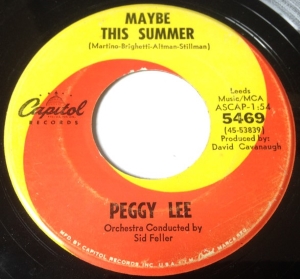
Maybe This Summer (Bruno Martino, Bruno Brighetti, Arthur Altman, Al Stillman) (6/18/65)
Another English adaptation of an Italian song, “Maybe This Summer,” with lyrics by Arthur Altman and Al Stillman, was adapted from “Odio l’estate” by Bruno Brighetti (lyrics) and Bruno Martino (music). Lee’s recording appeared as the B-side of a Capitol single with “The Shadow of Your Smile (Love Theme from The Sandpiper).” Although the Altman-Stillman lyric has not been recorded beyond Lee’s version, more recent English lyrics by singer Susannah McCorkle (for her own recording) and Joel E. Siegel (introduced by singer-pianist Shirley Horn) have made the song better known, especially to jazz audiences.
Stop Living in the Past (Howlett Smith) (6/18/65)
Songwriter Howlett Smith (1933-2019) enjoyed success with the songs “Little Altar Boy” (recorded by the Carpenters, Vic Dana, Glen Campbell, and Andy Williams) and, with co-writer Spence Maxwell, “The Grass Is Greener” (recorded by Blossom Dearie, Eydie Gorme and Steve Lawrence, and Nancy Wilson). Lee was the only major artist to record Smith’s “Stop Living in the Past,” which appeared on a Capitol single with “I Go to Sleep” by Ray Davies of the Kinks – a fitting example from 1965 of how Lee didn’t live in the past where her repertoire was concerned, regularly exploring new material in a variety of musical styles over the course of a 54-year recording career. Sid Feller arranged and conducted “Stop Living in the Past” during a session for her album Then Was Then – Now Is Now!
Me and My Shadow (Dave Dreyer, Al Jolson, Billy Rose) (Second Alternate Version) (1/29/69)
Peggy Lee enjoyed putting a contemporary spin on a decades-old song, and one of the finest examples is her spare yet funky 1969 setting for “Me and My Shadow.” First recorded by “Whispering” Jack Smith in 1927, the song’s many interpreters in its first 40 years included Pearl Bailey, Perry Como, Bing Crosby, Vic Damone, Judy Garland, Julie London, the Mills Brothers, and Lou Rawls. Lee’s version, featured on both the album and single for her Grammy-winning Is That All There Is?, was recorded in late January or early February 1969 with only a rhythm section (piano, bass guitar, drums), in an arrangement by Mundell Lowe. Earlier in January she had recorded a version with full orchestra, arranged by Randy Newman, that was dropped but can be heard as a bonus track on the digital edition of the Is That All There Is? album. The version here is an alternate take from her session with a rhythm section; the spare backing makes the many subtle differences in Lee’s vocal more apparent. Lee performed the song memorably, surrounded by her musicians, on a Kraft Music Hall episode in early 1970.
No More (Bob Russell, Toots Camarata) (2/12/69)
“No More” is one of many songs closely associated with Billie Holiday, who introduced it with her 1944 recording for Decca, conducted by the song’s composer, Tutti “Toots” Camarata. In the 1950s and 1960s the song was recorded by Lorez Alexandria, June Christy, Irene Kral, Abbey Lincoln, Carmen McRae, Jeri Southern and Dinah Washington. This 1969 recording by Lee originates from her A Natural Woman sessions, but the song was not included on the album for unknown reasons. Bobby Bryant was most likely the arranger. The song’s lyricist, Bob Russell, penned lyrics to many popular songs, including several with Duke Ellington; Lee memorably recorded Russell’s “You Came a Long Way from St. Louis” (written with John Benson Brooks).
Didn’t We (Jimmy Webb) (10/14/69)
While only in his early 20s, songwriter Jimmy Webb achieved massive success through hit recordings of such songs as “By the Time I Get to Phoenix,” “Up, Up and Away” and “Wichita Lineman.” Another early hit for Webb was “Didn’t We,” recorded by Vic Damone, Billy Eckstine, Astrud Gilberto, Eydie Gorme, Robert Goulet, Richard Harris, Johnny Hartman, Johnny Mathis, Carmen McRae, Helen Merrill, Liza Minnelli, Matt Monro, Anita O’Day, Frank Sinatra, Barbra Streisand, Sarah Vaughan, and Andy Williams, among many others. Lee recorded this version of “Didn’t We” during her Is That All There Is? album sessions, in an arrangement by Mundell Lowe. Although it remained unreleased until 2008, television audiences saw Lee sing it in 1969 on her special The World of Peggy Lee for National Educational Television, a forerunner of PBS. Lee also recorded Webb’s “By the Time I Get to Phoenix” for her 1968 album Two Shows Nightly.
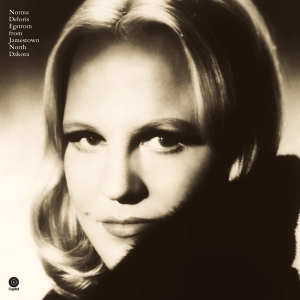
I’ll Be Seeing You (Sammy Fain, Irving Kahal) (Alternate Version) (4/28/72)
“I’ll Be Seeing You” served as the final track on Peggy Lee’s final album for Capitol, Norma Deloris Egstrom from Jamestown, North Dakota, and dates from her final recording session for the label, arranged and conducted by Artie Butler. It was the second “vintage” song in a medley on that otherwise very contemporary album, preceded by “The More I See You,” a song from 1945. “I’ll Be Seeing You” dates back to the late 1930s and is one of several popular songs of that era in which the singer reminisces to her lover about meaningful scenes and moments from their romantic past (see also: 1936’s “These Foolish Things” and 1937’s “Thanks for the Memory”). “Seeing” was introduced by Tamara in the 1938 Broadway musical Right This Way and first recorded commercially in 1940 by Dick Todd, a singer known as the Canadian Crosby. Frank Sinatra recorded it with Tommy Dorsey, also in 1940, and four years later it was recorded by the American Crosby – Bing – as well as Billie Holiday and Jo Stafford. Although Lee sang it on radio in the late 1940s and on television in the early 1950s, it wasn’t until its appearance on 1972’s Norma that it became one of her many signature songs. For the remainder of her performing career, which ended in 1995, it was usually her closing number in concert. This alternate version, which is slightly longer than the version used, was included on a 2004 CD reissue of Norma and now makes its streaming debut.

